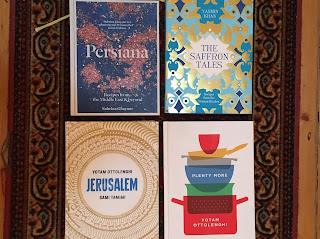Pomegranate Pop Culture
A pomegranate tree grew in the front garden of my childhood home. It was therefore normal to us kids, but I don’t recall ever having seen one anywhere else until I was an adult. Just the other day “pomegranates from Joe’s farm” were on sale in my local (and completely adorbs) corner store, and it got me thinking about how common they have been, especially in Australia, over the last few decades, so I decided to find out a little more.
I began my research the way all good research should begin, and called my mum for a chat. She had grown up in the same house, and I was curious to know how much she remembered of the pomegranate tree in the garden. It wasn’t there when she was a child, but it was there when she and my father bought the house from my grandfather and moved in when I was a baby. So how did it get there? Pomegranates are not a very 'Anglo’ fruit, so would, I thought, have been a little unusual in suburban Adelaide back in the day. According to mum*, the plant was popular at the time for a bit of exotic colour in the garden, although perhaps not planted for eating purposes.
These days, it feels as though pomegranate is all over the place, possibly as a result of what we can call “the Ottolenghi effect”. Pomegranates originated in Persia (modern day Iran) and Northern India, and have long been popular in Middle Eastern cuisine. The place of the pomegranate in cultural art and history is really fascinating. There are references to it as far back as 4000BC. In various cultures and religions from Ancient Egypt to Christianity the pomegranate represented life after death, prosperity and fertility, and was often celebrated for its perceived health-giving properties. Apparently, the fruit’s shape inspired the shape of King Solomon’s crown, and then all subsequent crown-y headpieces, which is a pretty big claim to fame for a little piece of fruit!
We picked and munched on the fruit as kids, but I had no idea that it was possible to do anything else with it (such as add to salads, serve with meat, turn into molasses and add to goodness-knows-what) until I came across my first Ottoleghi. If you have been living under a rock for the last decade or so, you may not know that Yotam Ottolenghi is the thinking woman’s Jamie Oliver. He grew up in Israel but now lives in London and is known for introducing new flavour combinations and ingredients to the Western cook. Pomegranate and pomegranate molasses feature in a number of his recipes.
If you come across pomegranate in a shop I would urge you to buy one and give it a try. It’s delicious to eat just as is, but if you’re feeling a little adventurous and don’t have a recipe to hand then you could easily add it to a simple salad. I used some of Joe’s pomegranates in a salad of baby spinach, red capsicum, salt, pepper, lemon juice and olive oil. It also goes really well with fresh tomato. If you're anything like me and would like an excuse to enable your ever-ready desire to accumulate more cookbooks, I would recommend the following as a start:
Persiana, Sabrina Ghayour
The Saffron Tales, Yasmin Khan
Plenty More, Yotam Ottolenghi
Jerusalem, Yotam Ottolenghi and Sami Tamimi
*Genuine academic source

Comments
Post a Comment